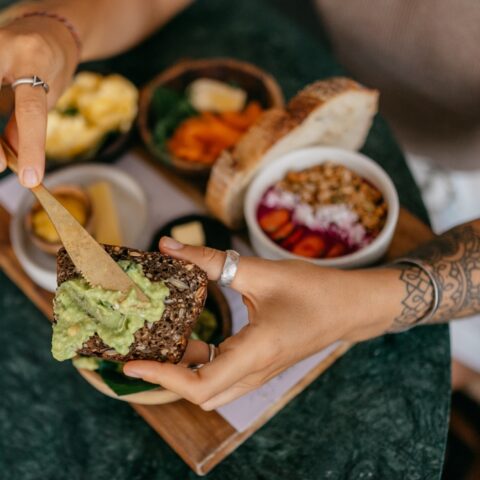Plant Protein vs. Animal Protein: What’s The Difference?

People often ask us: are plant-based proteins just as good as animal proteins? The answer is no: in the current debate of plant protein vs animal protein, the science clearly shows that meat, seafood, and eggs are far superior protein sources and better for health than plant-based protein sources for several reasons. One reason is that animal proteins are a complete source of protein, containing all the essential amino acids needed in your diet. Conversely, you’d need to eat a specific variety of plant-based foods, and a lot of them, to get your daily fill.
The question of protein quality is important right now because there’s a massive shift underway in the food industry for eating “plant-based.”
While we agree that it’s important to eat lots of fruit and veggies, most “plant-based” products—such as “impossible” meat products—contain a lot more than just plants. These food products are highly processed with vegetable and seed oils, grains, soy, and legumes, which are all proven to be bad for your health. These meal alternatives may taste like meat, but many contain unhealthy ingredients and they don’t compare to animal foods in terms of protein quality. These plant-based products are definitely not a healthier choice over meat!
Here’s a deeper dive into why getting enough animal protein is important for your overall health.
Related: Is The Paleo Diet Meat- or Plant-Based?
How We Determine Protein Quality
Before answering the question of why animal proteins are so important for good health, we need to understand what determines the quality of a source of protein. There are two main factors to consider: the amino acid profile of the protein and the bioavailability of the protein. [1]
All proteins are made up of strings of amino acids such as histidine, isoluecine, lysine, and valine. When we eat a protein, our bodies break the protein down to its amino acids, and then we use these amino acids to build the proteins that our bodies need. Of the 20 common amino acids, nine are considered “essential” because our bodies cannot synthesize them and so we need to get them from the foods we eat. The quality of the protein we consume is partially determined by whether it contains all of these essential amino acids and how closely it has them in the ratios we need. This is referred to as the amino acid profile of a protein.
Just as important is the bioavailability of a protein. A protein source may contain all of the essential amino acids, but if it’s hard for our digestive systems to break down that protein and absorb those amino acids, then the protein isn’t a great source for us. The protein source is said to have a low bioavailability.
A high-quality protein has both a good profile of essential amino acids and those amino acids are highly bioavailable for breakdown and absorption.
Why Amino Acids Are Important for Overall Good Health
Three of the essential amino acids—isoleucine, leucine, and valine—are called branched-chain amino acids and are extremely important for muscle health, which affects metabolic health. Unfortunately, plant-based protein sources are typically low in these three essential amino acids.
While we all need protein, some of us need a little more than others, like athletes and older adults. In fact, evidence from the PROT-AGE Study Group show that older adults need more dietary protein than younger adults to support good health, promote recovery from illness, and maintain function. [2] This age-related increased need for protein is due to age-related changes in protein metabolism, such as high splanchnic extraction and declining anabolic responses to ingested protein.
Why Animal Proteins Are Superior to Plant-Based Proteins
When differentiating between plant protein and animal protein, it is most pertinent to look at the essential amino acid profile, and particularly the branched-chain amino acids. As an example, the adult recommended daily allowance (RDA) for leucine is 42 mg/kg body weight, which is 2.94 grams for a 70 kg person. [3] That RDA can be accomplished with the consumption of just 100 grams of beef skirt steak—that’s only a 3.5-ounce steak. [4] You would have to eat twice the amount of firm tofu or almost five times the amount of canned navy beans to obtain the RDA for leucine! And those quantities still don’t consider whether tofu or canned beans supply the other essential amino acids, never mind the fact that soy and legumes are unhealthy.
Similarly, you would have to eat over 2.5 times the amount of pumpkin seeds compared to beef skirt steak to obtain the same amount of lysine.
While mixing plant foods can meet the RDA for essential amino acids (so long as you have a strong understanding of the best plant-based proteins and how to mix them), it requires you to consume a much larger quantity of those plant foods, which of course means consuming a lot more calories and more carbohydrates. That can be problematic if you’re looking to improve metabolic health conditions like insulin-resistance or diabetes.
To put it into perspective: we can compare animal and plant protein sources using the DIAAS protein quality rating which factors in both the amino acid profile of a protein and it’s bioavailability. The lowest animal protein is chicken at 108, and the highest plant protein is chickpeas at 83. [5, 6]
The scientific data is very clear that animal proteins, pound for pound, are significantly superior in quality to plant proteins.
Comparing the Quality of Animal Proteins
Now, let’s compare the quality of proteins between different animal sources. We can examine both the essential amino acid profile of some different animal proteins along with their DIAAS quality scores, where available.
Table 1 shows the essential amino acid quantities for some select animal proteins, and chickpeas, as well as the U.S. Recommended Daily Allowance for each amino acid:
![Table 1. DIAAS and essential amino acid quantities* [grams/100 grams (3.5 oz)] for select cooked animal proteins and chickpeas, and the RDA for each amino acid in mg/kg/d and in grams for a 70 kg person. Green shaded boxes indicate RDA is met for a 70 kg person with a 3.5-ounce serving.
*United States Department of Agriculture FoodData Central database (https://fdc.nal.usda.gov/)](https://thepaleodiet.com/wp-content/uploads/2023/05/Protein-Quality-of-Animal-Proteins-vs.-Plant-Proteins-1900x1300-1-1440x978.jpg)
Beef is by far the best animal source of essential amino acids. It has a very high DIAAS score and eight out of nine RDAs are satisfied with just one 3.5-ounce serving. However, further examination shows that all of the animal products can easily satisfy the RDA with three small servings per day.
The Bottom Line
The science of The Paleo Diet shows that humans are omnivores and that our healthiest diet includes plenty of fresh vegetables and fruits. But when it comes to getting enough protein, it takes just three relatively small servings of any animal protein to easily satisfy our bodies’ protein needs. Getting the protein we need from only plants is harder because of the amino acid profiles and bioavailability of plant-based proteins. But it’s possible; eating the right mix of specific plants in larger quantities can satisfy our protein needs. While you can certainly favor what you enjoy the most, it’s best to vary your animal protein sources when you can.
References
[1] Dietary protein quality evaluation in human nutrition. Report of an FAQ Expert Consultation. FAO Food Nutr Pap. 2013;92:1-66. PMID: 26369006. http://www.fao.org/ag/humannutrition/35978-02317b979a686a57aa4593304ffc17f06.pdf
[2] Bauer J, Biolo G, Cederholm T, Cesari M, Cruz-Jentoft AJ, Morley JE, et al. Evidence-Based Recommendations for Optimal Dietary Protein Intake in Older People: A Position Paper From the PROT-AGE Study Group. J Am Med Dir Assoc 2013;14:542–59. https://doi.org/10.1016/j.jamda.2013.05.021.
[3] Institute of Medicine (2002). “Protein and Amino Acids”. Dietary Reference Intakes for Energy, Carbohydrates, Fiber, Fat, Fatty Acids, Cholesterol, Protein, and Amino Acids. Washington, DC: The National Academies Press. pp. 589-768. https://doi.org/10.17226/10490.
[4] United States Department of Agriculture FoodData Central database (https://fdc.nal.usda.gov/).
[5] Phillips SM. Current Concepts and Unresolved Questions in Dietary Protein Requirements and Supplements in Adults. Frontiers Nutrition 2017;4:13. https://doi.org/10.3389/fnut.2017.00013.
[6] Ertl P, Knaus W, Zollitsch W. An approach to including protein quality when assessing the net contribution of livestock to human food supply. Animal 2016;10:1883–9. https://doi.org/10.1017/s1751731116000902.




